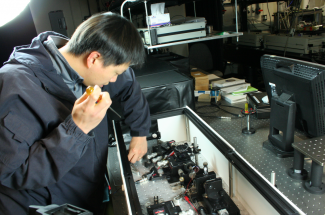When former graduate student Mingming Feng started his thesis project, his goal was to build and characterize a mode-locked quantum dot diode laser in Kevin Silverman’s lab at the National Institute of Standards and Technology (NIST). Feng chose this lab (after consultation with his advisor Steve Cundiff) because Silverman not only does a lot of work on diode laser development, but also collaborates regularly with Cundiff. As an added plus, Silverman’s lab was near the lab of NIST’s Richard Mirin, who is a world-class fabricator of semiconductor structures, including quantum dots.
As Feng began building his new laser, it never occurred to him that he was about to make a startling discovery. He expected his laser would produce the trains of bright pulses typical of a mode-locked laser linked to an external optical cavity; his job would be to tweak the new laser to make the pulses as bright and stable as possible and see if it offered advantages over other diode lasers.
However, when it lased, the new quantum-dot diode laser emitted a train of dark pulses. Instead of the expected bright pulses, i.e., increases in the laser intensity, the dark pulses were actually intensity dips occurring on a background of continuouswave lasing. Feng couldn’t believe his eyes. He kept going back to take new data to see if the dark pulses were real, or just some kind of crazy artifact.
The dark pulses turned out to be quite real. In fact, an examination of the master equation for mode-locked lasers revealed that a dark pulse train is a perfectly good solution for this equation. In theory at least, the possibility of a dark pulse laser had been there all the time. It was simply so counterintuitive that no one had noticed what had been sitting there in plain sight — until Feng garnered irrefutable experimental evidence that his laser had indeed gone over to the dark side.
This evidence included studies of the stability of the dark pulses using simulations. These studies were consistent with what was observed in the laboratory.
All in all, it was an exciting discovery for Feng and his colleagues. However, the dark pulse laser doesn’t appear to have much of a future either as a research tool or a practical device. Nobody, including Feng, has any idea of what to actually do with it. - Julie Phillips




